check engine KIA Optima Hybrid 2011 3.G Workshop Manual
[x] Cancel search | Manufacturer: KIA, Model Year: 2011, Model line: Optima Hybrid, Model: KIA Optima Hybrid 2011 3.GPages: 394, PDF Size: 8.63 MB
Page 344 of 394
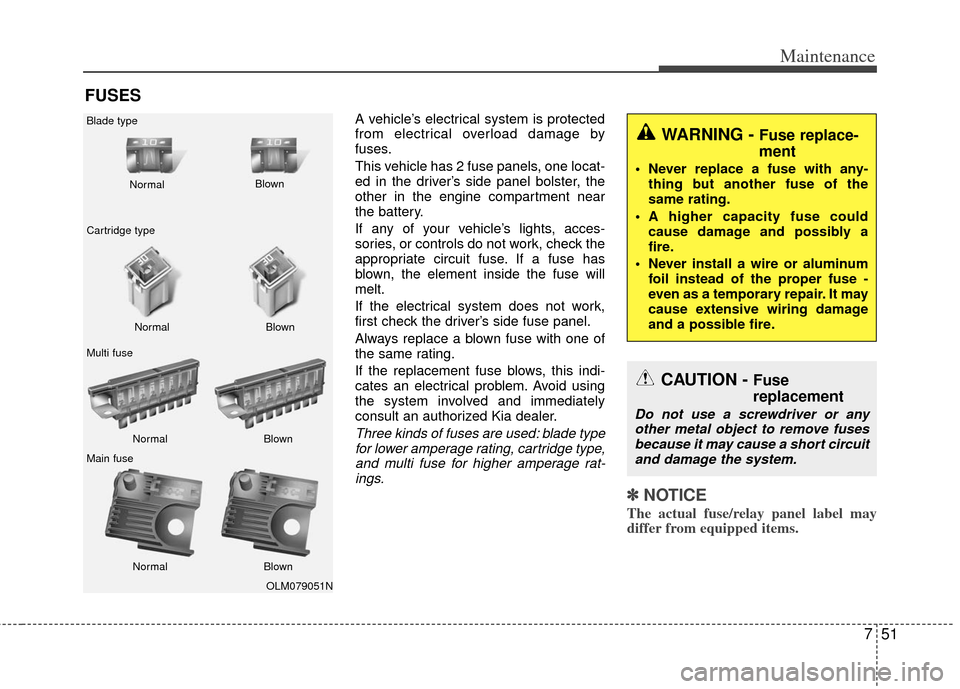
751
Maintenance
FUSES
A vehicle’s electrical system is protected
from electrical overload damage by
fuses.
This vehicle has 2 fuse panels, one locat-
ed in the driver’s side panel bolster, the
other in the engine compartment near
the battery.
If any of your vehicle’s lights, acces-
sories, or controls do not work, check the
appropriate circuit fuse. If a fuse has
blown, the element inside the fuse will
melt.
If the electrical system does not work,
first check the driver’s side fuse panel.
Always replace a blown fuse with one of
the same rating.
If the replacement fuse blows, this indi-
cates an electrical problem. Avoid using
the system involved and immediately
consult an authorized Kia dealer.
Three kinds of fuses are used: blade typefor lower amperage rating, cartridge type,and multi fuse for higher amperage rat-ings.
✽ ✽ NOTICE
The actual fuse/relay panel label may
differ from equipped items.
WARNING - Fuse replace-
ment
Never replace a fuse with any-
thing but another fuse of the
same rating.
A higher capacity fuse could cause damage and possibly a
fire.
Never install a wire or aluminum foil instead of the proper fuse -
even as a temporary repair. It may
cause extensive wiring damage
and a possible fire.
CAUTION - Fuse
replacement
Do not use a screwdriver or anyother metal object to remove fuses because it may cause a short circuitand damage the system.
OLM079051N
Normal
Normal
Blade type
Cartridge type
Multi fuse
Main fuse Blown
Blown
Normal Blown
Normal Blown
Page 345 of 394
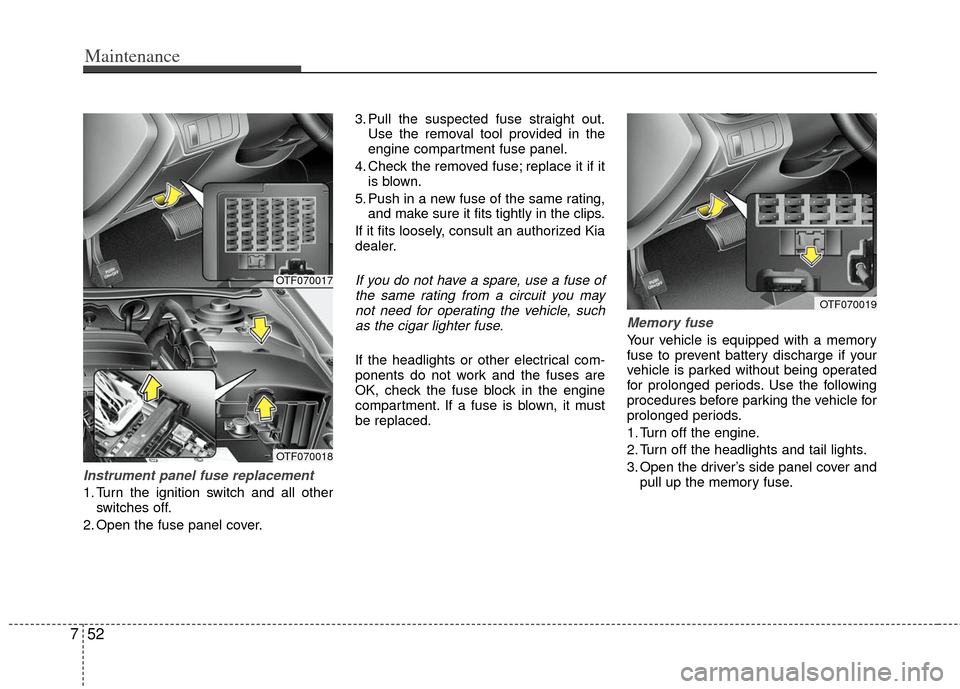
Maintenance
52
7
Instrument panel fuse replacement
1. Turn the ignition switch and all other
switches off.
2. Open the fuse panel cover. 3. Pull the suspected fuse straight out.
Use the removal tool provided in the
engine compartment fuse panel.
4. Check the removed fuse; replace it if it is blown.
5. Push in a new fuse of the same rating, and make sure it fits tightly in the clips.
If it fits loosely, consult an authorized Kia
dealer.
If you do not have a spare, use a fuse of the same rating from a circuit you maynot need for operating the vehicle, suchas the cigar lighter fuse.
If the headlights or other electrical com-
ponents do not work and the fuses are
OK, check the fuse block in the engine
compartment. If a fuse is blown, it must
be replaced.
Memory fuse
Your vehicle is equipped with a memory
fuse to prevent battery discharge if your
vehicle is parked without being operated
for prolonged periods. Use the following
procedures before parking the vehicle for
prolonged periods.
1. Turn off the engine.
2. Turn off the headlights and tail lights.
3. Open the driver’s side panel cover and pull up the memory fuse.
OTF070019
OTF070017
OTF070018
Page 346 of 394
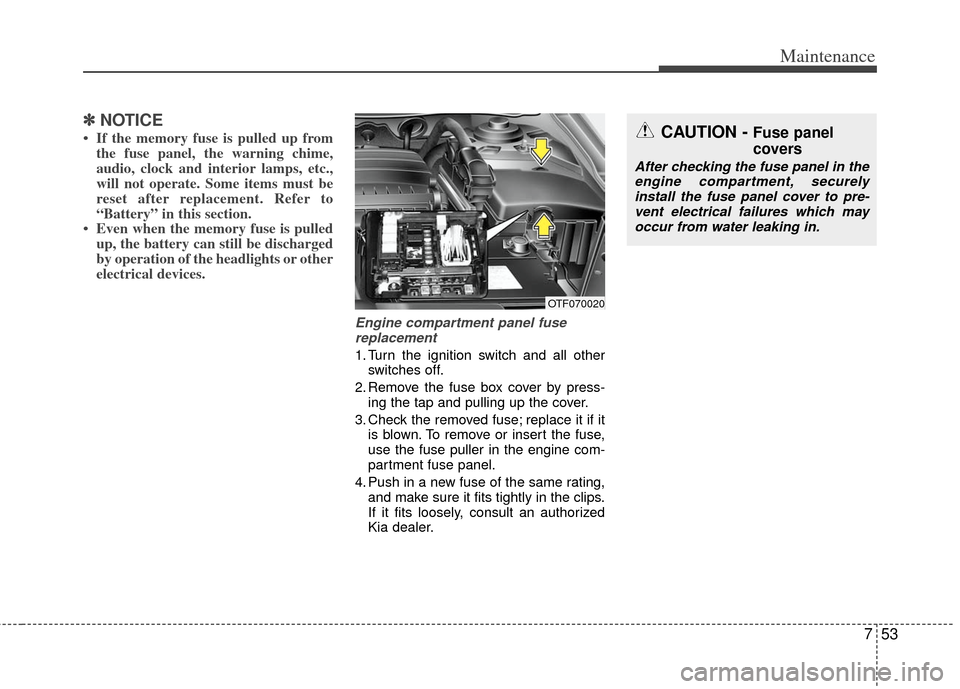
753
Maintenance
✽
✽NOTICE
• If the memory fuse is pulled up from
the fuse panel, the warning chime,
audio, clock and interior lamps, etc.,
will not operate. Some items must be
reset after replacement. Refer to
“Battery” in this section.
• Even when the memory fuse is pulled up, the battery can still be discharged
by operation of the headlights or other
electrical devices.
Engine compartment panel fuse
replacement
1. Turn the ignition switch and all other switches off.
2. Remove the fuse box cover by press- ing the tap and pulling up the cover.
3. Check the removed fuse; replace it if it is blown. To remove or insert the fuse,
use the fuse puller in the engine com-
partment fuse panel.
4. Push in a new fuse of the same rating, and make sure it fits tightly in the clips.
If it fits loosely, consult an authorized
Kia dealer.
CAUTION - Fuse panel
covers
After checking the fuse panel in theengine compartment, securely install the fuse panel cover to pre-vent electrical failures which mayoccur from water leaking in.
OTF070020
Page 351 of 394
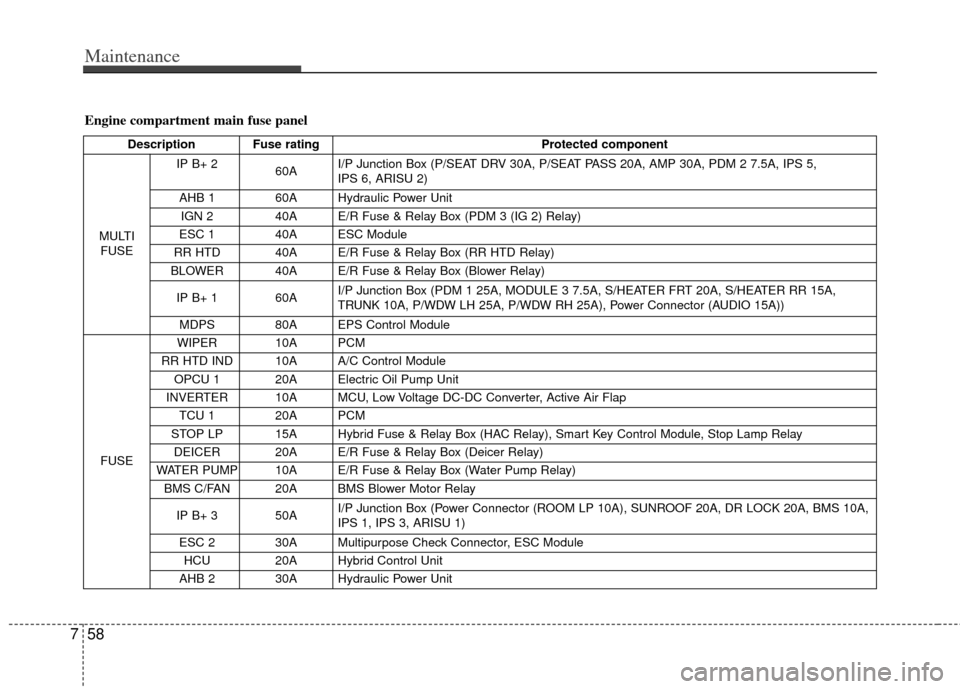
Maintenance
58
7
Engine compartment main fuse panel
Description Fuse rating Protected component
MULTI FUSE IP B+ 2
60AI/P Junction Box (P/SEAT DRV 30A, P/SEAT PASS 20A, AMP 30A, PDM 2 7.5A, IPS 5,
IPS 6, ARISU 2)
AHB 1 60A Hydraulic Power Unit IGN 2 40A E/R Fuse & Relay Box (PDM 3 (IG 2) Relay)
ESC 1 40A ESC Module
RR HTD 40A E/R Fuse & Relay Box (RR HTD Relay)
BLOWER 40A E/R Fuse & Relay Box (Blower Relay)
IP B+ 1 60A I/P Junction Box (PDM 1 25A, MODULE 3 7.5A, S/HEATER FRT 20A, S/HEATER RR 15A,
TRUNK 10A, P/WDW LH 25A, P/WDW RH 25A), Power Connector (AUDIO 15A))
MDPS 80A EPS Control Module
FUSE WIPER 10A PCM
RR HTD IND 10A A/C Control Module OPCU 1 20A Electric Oil Pump Unit
INVERTER 10A MCU, Low Voltage DC-DC Converter, Active Air Flap TCU 1 20A PCM
STOP LP 15A Hybrid Fuse & Relay Box (HAC Relay), Smart Key Control Module, Stop Lamp Relay DEICER 20A E/R Fuse & Relay Box (Deicer Relay)
WATER PUMP 10A E/R Fuse & Relay Box (Water Pump Relay) BMS C/FAN 20A BMS Blower Motor Relay
IP B+ 3 50A I/P Junction Box (Power Connector (ROOM LP 10A), SUNROOF 20A, DR LOCK 20A, BMS 10A,
IPS 1, IPS 3, ARISU 1)
ESC 2 30A Multipurpose Check Connector, ESC Module HCU 20A Hybrid Control Unit
AHB 2 30A Hydraulic Power Unit
Page 362 of 394
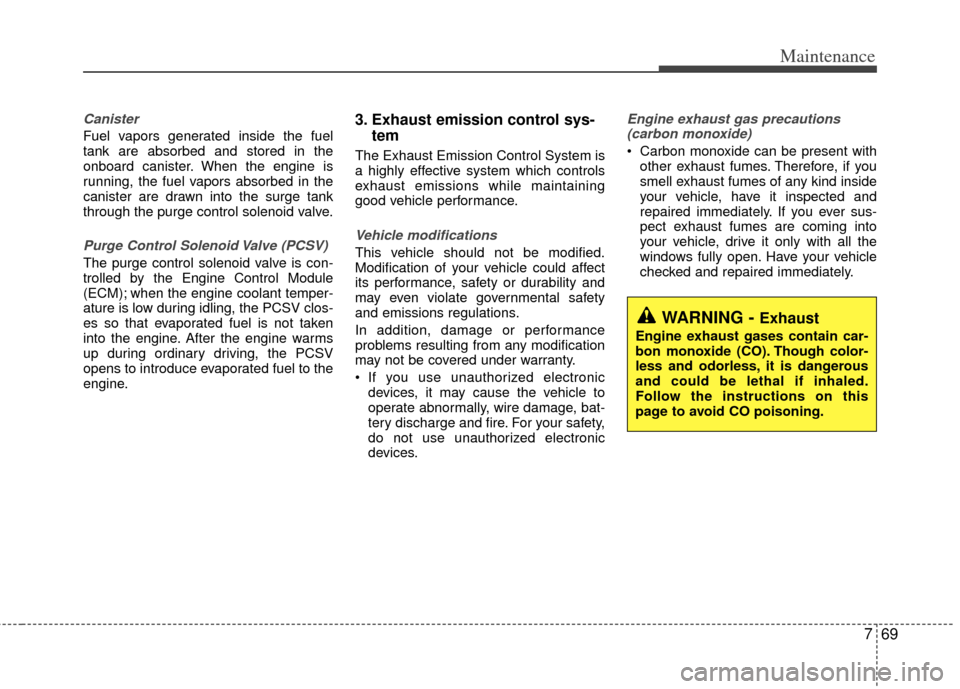
769
Maintenance
Canister
Fuel vapors generated inside the fuel
tank are absorbed and stored in the
onboard canister. When the engine is
running, the fuel vapors absorbed in the
canister are drawn into the surge tank
through the purge control solenoid valve.
Purge Control Solenoid Valve (PCSV)
The purge control solenoid valve is con-
trolled by the Engine Control Module
(ECM); when the engine coolant temper-
ature is low during idling, the PCSV clos-
es so that evaporated fuel is not taken
into the engine. After the engine warms
up during ordinary driving, the PCSV
opens to introduce evaporated fuel to the
engine.
3. Exhaust emission control sys-tem
The Exhaust Emission Control System is
a highly effective system which controls
exhaust emissions while maintaining
good vehicle performance.
Vehicle modifications
This vehicle should not be modified.
Modification of your vehicle could affect
its performance, safety or durability and
may even violate governmental safety
and emissions regulations.
In addition, damage or performance
problems resulting from any modification
may not be covered under warranty.
If you use unauthorized electronic
devices, it may cause the vehicle to
operate abnormally, wire damage, bat-
tery discharge and fire. For your safety,
do not use unauthorized electronic
devices.
Engine exhaust gas precautions(carbon monoxide)
Carbon monoxide can be present with other exhaust fumes. Therefore, if you
smell exhaust fumes of any kind inside
your vehicle, have it inspected and
repaired immediately. If you ever sus-
pect exhaust fumes are coming into
your vehicle, drive it only with all the
windows fully open. Have your vehicle
checked and repaired immediately.
WARNING - Exhaust
Engine exhaust gases contain car-
bon monoxide (CO). Though color-
less and odorless, it is dangerous
and could be lethal if inhaled.
Follow the instructions on this
page to avoid CO poisoning.
Page 369 of 394
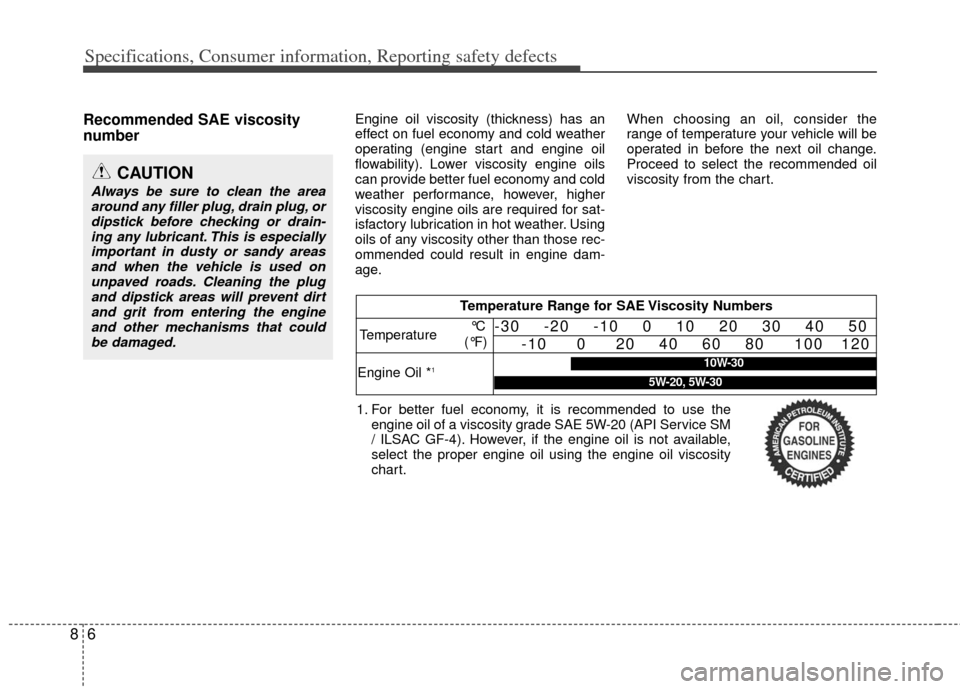
Specifications, Consumer information, Reporting safety defects
68
Recommended SAE viscosity
number Engine oil viscosity (thickness) has an
effect on fuel economy and cold weather
operating (engine start and engine oil
flowability). Lower viscosity engine oils
can provide better fuel economy and cold
weather performance, however, higher
viscosity engine oils are required for sat-
isfactory lubrication in hot weather. Using
oils of any viscosity other than those rec-
ommended could result in engine dam-
age.When choosing an oil, consider the
range of temperature your vehicle will be
operated in before the next oil change.
Proceed to select the recommended oil
viscosity from the chart.
CAUTION
Always be sure to clean the area
around any filler plug, drain plug, ordipstick before checking or drain-ing any lubricant. This is especiallyimportant in dusty or sandy areasand when the vehicle is used on unpaved roads. Cleaning the plugand dipstick areas will prevent dirtand grit from entering the engineand other mechanisms that couldbe damaged.
Temperature Range for SAE Viscosity Numbers
Temperature
Engine Oil *
1
°C
(°F)-30 -20 -10 0 10 20 30 40 50 -10 0 20 40 60 80 100 120
1. For better fuel economy, it is recommended to use theengine oil of a viscosity grade SAE 5W-20 (API Service SM
/ ILSAC GF-4). However, if the engine oil is not available,
select the proper engine oil using the engine oil viscosity
chart.
10W-30
5W-20, 5W-30
Page 377 of 394
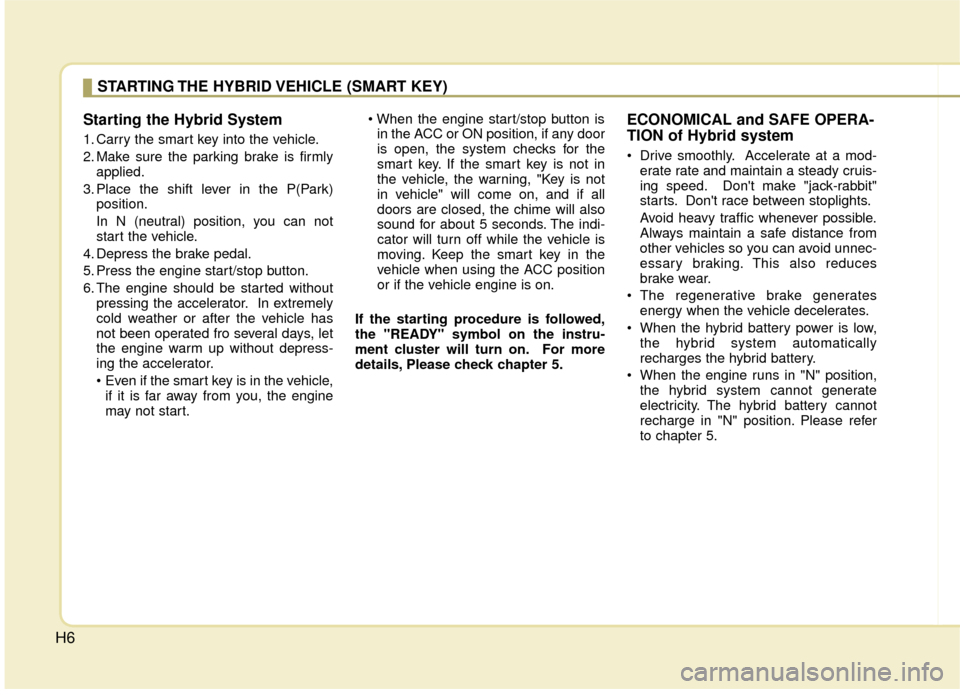
H6Starting the Hybrid System
1. Carry the smart key into the vehicle.
2. Make sure the parking brake is firmly
applied.
3. Place the shift lever in the P(Park) position.
In N (neutral) position, you can not
start the vehicle.
4. Depress the brake pedal.
5. Press the engine start/stop button.
6. The engine should be started without pressing the accelerator. In extremely
cold weather or after the vehicle has
not been operated fro several days, let
the engine warm up without depress-
ing the accelerator.
• Even if the smart key is in the vehicle,if it is far away from you, the engine
may not start.
in the ACC or ON position, if any door
is open, the system checks for the
smart key. If the smart key is not in
the vehicle, the warning, "Key is not
in vehicle" will come on, and if all
doors are closed, the chime will also
sound for about 5 seconds. The indi-
cator will turn off while the vehicle is
moving. Keep the smart key in the
vehicle when using the ACC position
or if the vehicle engine is on.
If the starting procedure is followed,
the "READY" symbol on the instru-
ment cluster will turn on. For more
details, Please check chapter 5.
ECONOMICAL and SAFE OPERA-
TION of Hybrid system
Drive smoothly. Accelerate at a mod- erate rate and maintain a steady cruis-
ing speed. Don't make "jack-rabbit"
starts. Don't race between stoplights.
Avoid heavy traffic whenever possible.
Always maintain a safe distance from
other vehicles so you can avoid unnec-
essary braking. This also reduces
brake wear.
The regenerative brake generates energy when the vehicle decelerates.
When the hybrid battery power is low, the hybrid system automatically
recharges the hybrid battery.
When the engine runs in "N" position, the hybrid system cannot generate
electricity. The hybrid battery cannot
recharge in "N" position. Please refer
to chapter 5.
STARTING THE HYBRID VEHICLE (SMART KEY)
Page 388 of 394
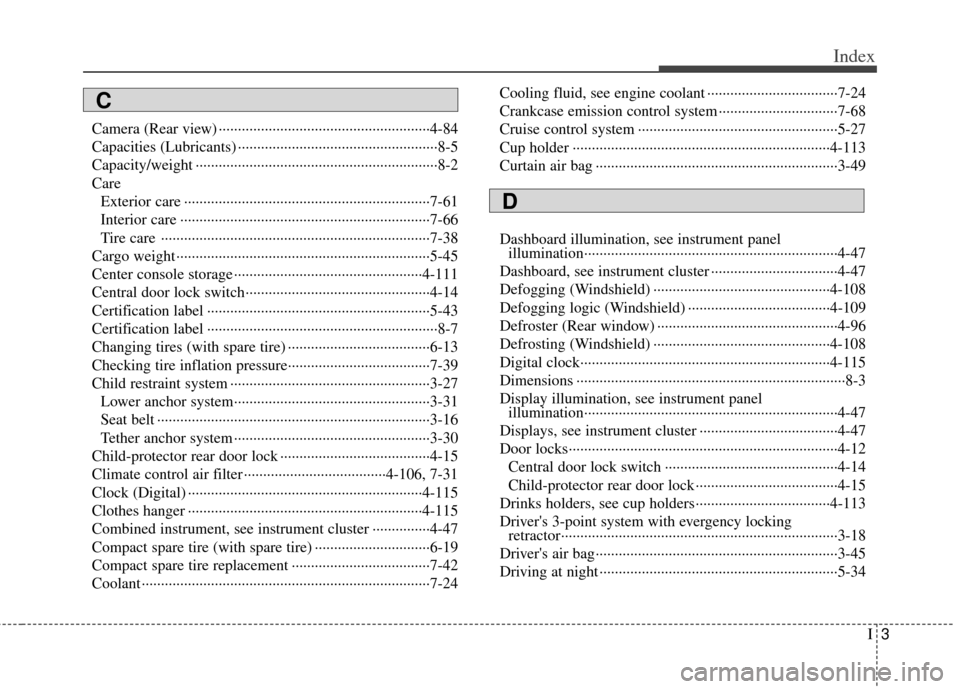
I3
Index
Camera (Rear view) ··················\
··················\
··················\
·4-84
Capacities (Lubricants) ··················\
··················\
················8-5
Capacity/weight ··················\
··················\
··················\
·········8-2
CareExterior care ··················\
··················\
··················\
··········7-61
Interior care ··················\
··················\
··················\
···········7-66
Tire care ··················\
··················\
··················\
················7-38
Cargo weight ··················\
··················\
··················\
············5-45
Center console storage ··················\
··················\
·············4-111
Central door lock switch··················\
··················\
············4-14
Certification label ··················\
··················\
··················\
····5-43
Certification label ··················\
··················\
··················\
······8-7
Changing tires (with spare tire) ··················\
··················\
·6-13
Checking tire inflation pressure··················\
··················\
·7-39
Child restraint system ··················\
··················\
················3-27 Lower anchor system··················\
··················\
···············3-31
Seat belt ··················\
··················\
··················\
·················3-16\
Tether anchor system ··················\
··················\
···············3-30
Child-protector rear door lock ··················\
··················\
···4-15
Climate control air filter ··················\
··················\
·4-106, 7-31
Clock (Digital) ··················\
··················\
··················\
·······4-115
Clothes hanger ··················\
··················\
··················\
·······4-115
Combined instrument, see instrument cluster ···············4-47
Compact spare tire (with spare tire) ··················\
············6-19
Compact spare tire replacement ··················\
··················\
7-42
Coolant ··················\
··················\
··················\
··················\
···7-24 Cooling fluid, see engine coolant ··················\
················7-24
Crankcase emission control system ··················\
·············7-68
Cruise control system ··················\
··················\
················5-27
Cup holder ··················\
··················\
··················\
·············4-113
Curtain air bag ··················\
··················\
··················\
·········3-49
Dashboard illumination, see instrument panel
illumination··················\
··················\
··················\
············4-47
Dashboard, see instrument cluster ··················\
···············4-47
Defogging (Windshield) ··················\
··················\
··········4-108
Defogging logic (Windshield) ··················\
··················\
·4-109
Defroster (Rear window) ··················\
··················\
···········4-96
Defrosting (Windshield) ··················\
··················\
··········4-108
Digital clock··················\
··················\
··················\
···········4-115
Dimensions ··················\
··················\
··················\
················8-3
Display illumination, see instrument panel illumination··················\
··················\
··················\
············4-47
Displays, see instrument cluster ··················\
··················\
4-47
Door locks··················\
··················\
··················\
················4-12 Central door lock switch ··················\
··················\
·········4-14
Child-protector rear door lock ··················\
··················\
·4-15
Drinks holders, see cup holders··················\
·················4-11\
3
Driver's 3-point system with evergency locking retractor··················\
··················\
··················\
··················\
3-18
Driver's air bag··················\
··················\
··················\
·········3-45
Driving at night ··················\
··················\
··················\
········5-34
C
D